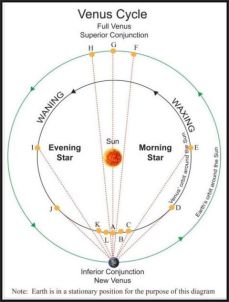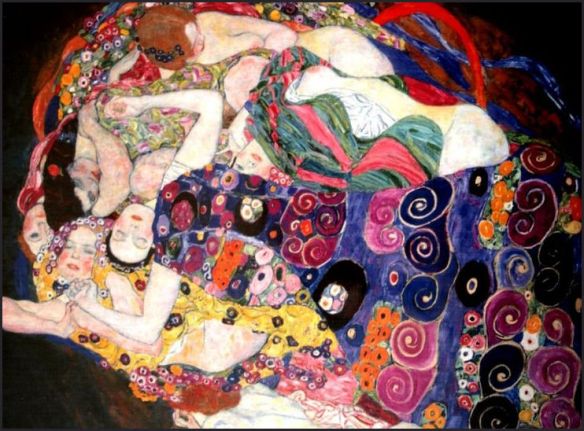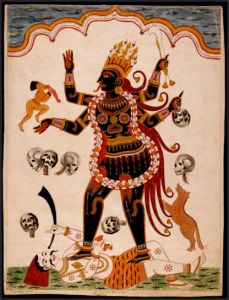It seems particularly apt to begin this article with a reference to Gustav Klimt’s “The Die Jungfrauen” (The Virgins) 1913 shown above because it celebrates the stages of a woman’s life and the intertwining rhythms and themes which I would like to explore in reference to the understanding of Venus. This work isn’t to read as a single moment in time, but as depicting the evolution into womanhood. The curator at the Klimt Museum notes that there ” are six women in the painting (or one woman with four sides to her persona) and all of them seem to be intertwined. The lines are clear and the human themes of love, sexuality, and regeneration are obvious in the circular cyclical shape of the work. In painting The Virgins the different life stages are represented by the same woman. Dislocated body parts in outrageous poses move as if underwater. The empty shell of a woman’s dress at the bottom gives birth to a child (the next generation) via a cascading waterfall of colour.”
In order to understand the essence of a thing, it behoves us to discover and contemplate its origin. But Aphrodite is not a thing, she is an archetype used to inform us of the meaning of the planet Venus. For those wishing to avoid a psychological approach, Plato’s Forms will adequately explain the relationship. Not everyone will be happy when I suggest that the better an astrologer understands the essence of the signs and planets, the better astrologer he will be. . I would suggest that it isn’t enough to say that astrology is a symbolic language. It is that too, but one needs to know what the symbol points to in all its wealth of meaning.
There is a view among some so-called traditional astrologers that astrological delineation is a more or less a mechanical process. Any reference to myth or spirituality is seen as a betrayal of tradition. I think the reverse is true. The history and expression of astrology since earliest antiquity, and indeed even during the Paleolithic period, has always been imbued with a soul and I contend that it should be approached in this spirit.
Contemplating the origins of astrology fascinates me personally, but this is something that astrological thinkers have to do a great deal of. In order to know why there are twelve houses with specific significations, we need to go back to the beginnings of horoscopic astrology and indeed to that which preceded it. The same is true of the signs.
Most constellations look nothing like what they are purported to represent, yet the record shows us that for the most part there was a surprising degree of agreement on what they were. Why is that? We also gain a great deal by studying the earliest interpretations of the planets and the cosmologies that inform them. However, the understanding we have cannot be universal, unless we can truly understand the root essence of the meanings allocated to planets. Authentic astrology is rigorous and works on more than one dimension. As will become evident, with Venus the core meanings are in the Venus cycle and her associations with the feminine.
In the case of Venus, most modern and contemporary astrologers subscribe to the European understanding of the Roman Venus. She is absconded from Greek mythology to Rome. from Aphrodite to Venus. Not much else changes and she seems not just rather domesticated but separated from some of the most basic elements of the real feminine. This is the Venus we see in the newspaper columns and in popular star sign books, where Venus is almost always spoken of romantic. But even serious modern astrologers have a very narrow view of Venus. Presumably, William Lilly only had access to Classical and Medieval sources.
Lilly wrote: “”[QUALITIES OF MEN & THEIR PROFESSIONS.] Musitions, Gamesters, Silk—men, Mercers, Linnen—Drapers, Painters, Jewellers, Players, Lapidaries, Embroiderers, Women-tailors, Wives, Mothers, Virgins, Choristers, Fidlers, Pipers, when joyned with Moon, Singers, Perfumers, Semi lers, Picture—drawers, Gravers, Upholdsters, Limners, Glovers, all such as fell those Commodities which adorn Women either, in Body (as Cloaths) or in Face, (as Complexion-waters.)”
The list contains musicians, indeed all the decorous arts, and among the Venusian professions we have wives, mothers, and virgins. The portrait is suitably one of harmony, peace, and beauty. There is absolutely no doubt that all this belong to Aphrodite, but it is missing key feminine qualities on a grand scale. This is a somewhat sanitized version of the feminine and I’m reminded of the old English nursery rhyme: “sugar and spice and all things nice – that’s what little girls are made from.”

Venus Tablet of Ammisaduqa is the sixty-third Tablet of the Astronomical omen series Enuma Anu Enlil. The tablet records the heliacal risings and settings of the planet Venus (Ninsianna) for a period of twenty-one years. (British Museum).
The original ‘Venus” was Innana and was associated with the planet Venus and her phases. She was the Queen of the Night with a ferocious libido and her story passed down to us in the Babylonian sources is one of the earliest and most articulate representations of “hell hath no fury like a woman scorned.” Hers is a chthonic force that has no truck with the rational. She is a Kali – dishing out death while giving birth. – a goddess of Creation, Destruction, and Power. Indeed, the two are so similar, that it’s quite plausible that they derived from the same source.
In The Epic of Gilgamesh, Innana travels to the underworld, dies and is resurrected. This is a reference to the Venus cycle. Her period of visibility, including her passage as morning and evening star, is very close to the traditional period of the gestation cycle of 260 days, associating her with creation and childbirth. She is not visible for about three months of the year (about 105 days) which would correspond to Innana’s ‘death’ or passage to the underworld.
When Innan rises (as does Venus) she is rising before the Sun, ready for war. During this phase, she is also known as Lucifer and Phosphorous. This fire turns to more sensual pursuits when she is the evening star, behind the Sun. Here we once again see the Garden of Hesperides. The Mayans also placed multiple significance on the Venus cycle, identifying it with the gestation cycle and the growing cycle of maize. I recommend an article by Erika Reiner and David Pingree that provides a great deal of detail on this matter.
There is an important distinction to be made regarding Innana and her ‘successors.’ Inanna is not a Semitic deity. This is of some importance because of the cultural milieu. The early Sumerians clearly had a goddess-based religion. It is in her and her closest forms that the feminine has the capacity for its fullest expression. The more Patriarchal cultures of Greece and Rome to some extent recreated Venus in their own image – or more precisely in the image of a domesticated feminine who could occasionally be quite naughty, but a not a woman who occasionally expressed herself as a raging volcano. This is why cultural milieu is always relevant in deciphering these things. What is most striking is that the traits of the physical planetary Venus have been minimized. Classical or Hellenistic astrologers and those who followed did take the phases of Venus into account and this was true until at least the 18th Century. But Innana has been stripped of her chthonic and primal nature.
The writer  in the Encyclopaedia Britannica states: “Ishtar / Innan’s primary role in Sumer was that of fertility. However, she evolved into a far more complex character, with associations with death, the underworld and all kinds of catastrophic disasters in short order. She was a goddess of contradictory connotations, of comfort and wrath. fire and fire-quenching, rejoicing and weeping, justice fair and enmity. As a goddess of Venus, delighting in physical pleasure, she was the protectress of prostitutes and patroness of the alehouse. Part of her cult worship almost certainly involved temple prostitution.”
in the Encyclopaedia Britannica states: “Ishtar / Innan’s primary role in Sumer was that of fertility. However, she evolved into a far more complex character, with associations with death, the underworld and all kinds of catastrophic disasters in short order. She was a goddess of contradictory connotations, of comfort and wrath. fire and fire-quenching, rejoicing and weeping, justice fair and enmity. As a goddess of Venus, delighting in physical pleasure, she was the protectress of prostitutes and patroness of the alehouse. Part of her cult worship almost certainly involved temple prostitution.”
With the inception of Islam, there is a monumental shift in the meaning of Venus. Illustrations of the Islamic Venus, lack any real sensuality. She has the image of a beardless man and is mostly associated with music and dance, although she is considered the lesser benefic and Islam is said to be “under Venus,” in the same sense that Judaism is under Saturn.
Venus is the star in the Crescent of Islam. If we also consider Isis as an element of the Primordial Goddess, we can see how these Semitic, Mesopotamian. Egyptian and Roman manifestations of the goddess inform the culture as well as show how the feminine force was interpreted. Some cultures hold the goddess as a divine creator, while others perceive her in a more subservient role. No doubt this is a reflection of the cultural views of women. Nevertheless, I would say one ignores or underestimates the power of the feminine at their peril. It is not an irony that an acceptance of these traits enhances the more traditional ones. It is easier to understand Venus as the evening star if you know where she has come from and where she will return.
The extent to which anyone wishes to take this to heart is perhaps a personal matter. Nevertheless, the full spectrum of Venusian power will be better appreciated by examination of the essence and roots of the archetype and the close relationship to the planet Venus, in all her phases. I suspect it may also cause some to more closely examine the phases of Venus, which has been a core element in traditional astrology from the very beginning. Discussion of this subject can only provide a deeper understanding and illuminate both tradition and cultural bias.
Clearly, the main elements of this article require a later expansion – for example, the Venus phases themselves.. The Lunar cycle and the Venus cycle are intertwined and to a lesser extent, so are the phases of Mercury. The intent of this article is to raise some of the main issues regarding the interpretations of Venus.










